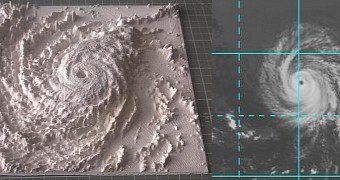Hurricanes are terrible natural phenomena, capable of great devastation, but to meteorologists that aren't in the direct line of destruction they can also be fascinating objects of study. Even common people might find themselves quite curious about them, if faced with a report or study on them.
Knowing this and having a large bunch of photos taken from orbit of hurricanes in general and many other wind-based phenomena, NASA has decided to bring hurricanes closer to the common man.
It sounds a bit morbid and worrisome when put like that, but a lot of things do, and we suppose that stranger things have happened than people becoming fascinated with the lethal. Like poodles.
All jests aside, though, NASA has released the 3D model of the hurricane Julio, meaning that you can use a 3D printer to create what amounts to a sculpture of the way the hurricane shows up in space.
The hurricane Julio
Tornadoes may be the wind calamities most famous for being giant funnels of violent air, but they are hardly the only winds that run around like twisters.
Indeed, hurricanes are quite similar, only they stretch for miles, far wider than tornadoes, but maintaining the same level of destructiveness, if not greater.
This is evidenced in the way they appear on satellite: gigantic, multi-armed spirals of clouds, resembling our galaxy itself in shape. Little wonder that the spiral is one of – if not the – most common shapes in nature.
The 3D model of hurricane Julio was posted online by Francis Reddy, a science writer who’s on contract with NASA’s Goddard Space Flight Center. In fact, the man has already 3D printed one for himself.
Julio was one of the least damaging hurricanes this year since, unlike the cyclone that Iselle turned into (when it struck Hawaii), Julio passed the island by without hitting it.
How the model was made
Reddy had to spend a while finding the right set of images to base the 3D model on, since he needed flat lighting. The gray value of the pixel is translated into height, and sunlight highlights striking the clouds at an angle created false elevations in the 3D design software.
He found the image he needed though, then merged it with another of similar quality and edited the model until he was satisfied. After that, it was a simple matter of simplifying the mesh and sending it to a printer. The GOES 15 satellite was the one that snapped the shots: one of the satellite photo, one of the infrared enhanced view (holding the temperatures of the cloud tops and, thus, heights).
Printing your own hurricane
You only need to download the .stl file from NASA and use a 3D printer to make it physical from whatever material you have. The default size is with a side of 5.3 inches / 135 mm (787 miles at scale).

 14 DAY TRIAL //
14 DAY TRIAL //